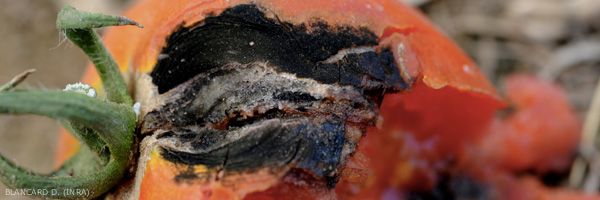
Alternaria alternata and other agents of black rot in fruits
Among the fungi that cause rot in black mold ( black mold rot ) on tomato fruit , several cause alterations characterized by tissue taking a black color and overlapping a mold similar color. This is particularly the case during the development of a species of Alternaria ; A. alternata (Fr.) Keissl. * (Syn. A. tenuis Nees) . It is a globally distributed saprophytic and opportunistic fungus. It belongs to the superficial flora of many plant species, and in particular to that of the tomato. It is very present in the environment of cultures and settles more and more easily on the fruits as they ripen. This damage is reported in many countries spread over all continents. It mainly affects fruits grown in the open field and in the flat.
- Symptoms
Lesions of limited size and poorly defined, concave and moist outline appear on the fruits initially. They are often located near the stem or in the stem area of the named fruit "shoulder" ( shoulder ) by the Anglo-Saxons (Figures 1 to 3). Subsequently, they gradually spread, and the subcuticular tissues located in their center soon turn brown and then blacken. Let us note that this fungus can colonize secondarily, like other species of Alternaria , the lesions caused by the physiological disease called apical necrosis of the tomato.
Ultimately, if the ambient humidity is high, the surface of the alterations becomes covered with a dense velvety texture, dark green to black, in particular at the level of small cracks that alter the epidermis. This mold is formed by the mycelium, conidiophores and the numerous conidia of Alternaria alternata . The spores of this fungus have relatively characteristic shapes; Figures 4 and 5 should allow you to easily identify them.
In some cases, small black globular structures form in the damaged tissue in place of previous molds (Figure 6). These symptoms are then caused by a Pleospora ( Pleospora herbarum ; syn .: Pleospora lycopersici ), teleomorph of a Stemphylium . These globular structures will in fact be perithecia containing several asci and ascospores.
Generic protection methods are available at the following link .
* Fungi, Ascomycota, Pezizomycotina, Dothideomycetes, Pleosporomycetidae, Pleosporales, Pleosporaceae
In some cases, small black globular structures form in the damaged tissue in place of previous molds (Figure 6). These symptoms are then caused by a Pleospora ( Pleospora herbarum ; syn .: Pleospora lycopersici ), teleomorph of a Stemphylium . These globular structures will in fact be perithecia containing several asci and ascospores.
Generic protection methods are available at the following link .
* Fungi, Ascomycota, Pezizomycotina, Dothideomycetes, Pleosporomycetidae, Pleosporales, Pleosporaceae





